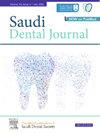The prevalence of mandibular lingual concavity among the Saudi population of Eastern Province: A CBCT evaluation
IF 2.3
Q3 DENTISTRY, ORAL SURGERY & MEDICINE
引用次数: 0
Abstract
Background
Anatomic variations can make placing implants in the mandible more complex. Exploring the variation in the presence of ridges and lingual concavity among different races and ethnicities is of therapeutic significance. The current study evaluates the prevalence and size of mandibular lingual concavity, which can cause surgical complications while inserting dental implants in the mandibular first molar area.
Methods
Two hundred and fifty-six cross-section images of the edentulous first molar region were examined. Within this geographical area, the structure of the lower jaw was categorized into three distinct types: C-configuration (convex), P-configuration (parallel), and U-configuration (with an undercut). The study was conducted at IAU College of Dentistry, Dammam. Data was gathered on the depth of the lingual concavity, the angle of the concavity, and other relevant factors. The data were analyzed with SPSS 20. A p-value ≤ 0.05 was considered significant.
Results
Of 256 subjects included in the study, 144 were males (M), and 112 were females (F). Various variables measured complimenting the lingual concavity showed no difference between the genders, except for the VCB “The vertical distance from the alveolar crest to line A” (p-value = 0.005). The division of ridges morphology as a whole was as follows: Convex (C), 70 (27.34 %), Parallel (P) 51 (19.92 %), and Undercut (U) type, 135 (52.73 %). The angle of concavity was 69.28 ± 14.41 % (M) and 67.09 ± 13.04 %. (F). Angle depth was 2.40 ± 1.72 % (M) and 2.36 ± 1.46 % (F); together, 2.38 ± 1.6 %.
Conclusion
It was concluded that U-type ridges were predominant (52.73%) with more chances of occurrence of lingual concavity. There were no differences between the genders except in one parameter. (VCB) Further studies are required to explore lingual concavity in more detail.
在东部省沙特人口中下颌舌凹的患病率:CBCT评估
背景:解剖学上的差异会使下颌骨植入物的放置变得更加复杂。探讨不同种族和民族间舌脊和舌凹存在的差异具有治疗意义。目前的研究评估下颌舌凹的患病率和大小,下颌舌凹在下颌第一磨牙区植入牙种植体时可能导致手术并发症。方法对256张无牙第一磨牙区域的横切面图像进行检查。在这个地理区域内,下颌的结构被分为三种不同的类型:c型(凸型)、p型(平行型)和u型(凹型)。这项研究是在达曼的IAU牙科学院进行的。收集舌凹深度、舌凹角度及其他相关因素的数据。数据采用SPSS 20进行分析。A p值≤0.05被认为是显著的。结果纳入研究的256名受试者中,男性144人(M),女性112人(F)。除了VCB“牙槽嵴到A线的垂直距离”(p值= 0.005)外,测量的舌凹度的各种变量在性别之间没有差异。脊型总体划分为凸型(C型)70个(27.34%),平行型(P型)51个(19.92%),凹型(U型)135个(52.73%)。凹凸角分别为69.28±14.41% (M)和67.09±13.04%。(F)。角深度为2.40±1.72% (M)和2.36±1.46% (F);合计2.38±1.6%。结论以u型牙脊为主(52.73%),舌侧凹陷发生率较高。除了一个参数外,性别之间没有差异。(VCB)需要进一步的研究来更详细地探讨舌凹性。
本文章由计算机程序翻译,如有差异,请以英文原文为准。
求助全文
约1分钟内获得全文
求助全文
来源期刊

Saudi Dental Journal
DENTISTRY, ORAL SURGERY & MEDICINE-
CiteScore
3.60
自引率
0.00%
发文量
86
审稿时长
22 weeks
期刊介绍:
Saudi Dental Journal is an English language, peer-reviewed scholarly publication in the area of dentistry. Saudi Dental Journal publishes original research and reviews on, but not limited to: • dental disease • clinical trials • dental equipment • new and experimental techniques • epidemiology and oral health • restorative dentistry • periodontology • endodontology • prosthodontics • paediatric dentistry • orthodontics and dental education Saudi Dental Journal is the official publication of the Saudi Dental Society and is published by King Saud University in collaboration with Elsevier and is edited by an international group of eminent researchers.
 求助内容:
求助内容: 应助结果提醒方式:
应助结果提醒方式:


